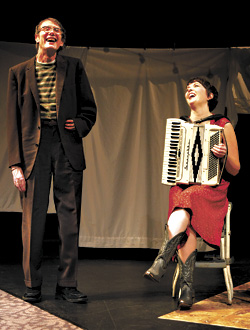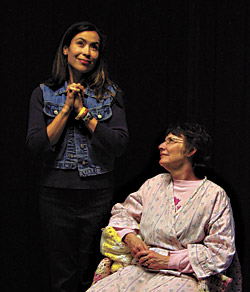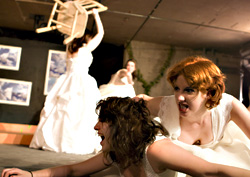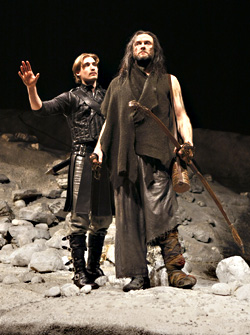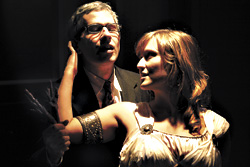Because Kevin Kling is a funny, foxily faux-folksy Minnesota public-radio storyteller at home on the stage and the page, he gets compared to Garrison Keillor. But I think of him more as part of what the Coen brothers (asked to define their own art) termed “the Midwest Wild-Ass School of Filmmaking.” Kling’s stories (about ice fishing, bus nuts, Curious George in hell, family barbecues, getting struck by lightning, and a Minnesota upbringing) are mini–indie films, shaggy dogs shaking their wild-ass wit all over the audience.
Kling had a 2001 motorbike crash so bad the docs had to refer to a precrash photo to put his face back on and his eye back in. He turned his life’s wreckage into seriocomic art, à la Julia Sweeney’s God Said Ha! His latest gallimaufry of monologues (akin to what you’ve heard on NPR) is called How? How? Why? Why? Why?, which is how his voice-recognition software translated the bowwows and meows of his cat and dogs (wonderfully named Fafnir, a wiener dog, and Percodan the basset hound—Dan for short).
One hesitates to quote his act because it’s so much funnier coming from him—ectomorphic as a space alien, attired in thrift-shop couture, peering quizzically from behind TV-sized specs with a goofy look like Jim Carrey if Carrey didn’t have to try so hard. He uses lots of one-liners, but they depend utterly on his ace timing and the context of his train of thought, which never quite goes off the rails but appears to be tossing rails down just before the engine of his madcap imagination hits them. He loved that 1963 BMW that almost killed him, he once said, because “you’re just ahead of yourself when you’re on a motorcycle. You are kind of living just before yourself.” In the show he recalls the exhilaration just before the crash: “Each gear takes you further away from yourself.”
That’s the way his art works when it’s working best: It doesn’t exactly know where it’s going, so when it gets there, there’s a frisson of surprise. One minute, he’s doing a Jean Shepherd–ish family reminiscence about a barbecue-crazed uncle who tells him, “There’s three things I never wash, and one of ’em is my grill.” Then he veers off into another order of story, about the moment he hovered between life and death, and realized death wasn’t necessarily the wrong choice, or the time he spurned a secure life with a willing girl in paradisiacal Australia for a stranger, more dangerous trip.
Kling hails Fafnir’s heroism—”You’ll never see a more can-do attitude in a can’t-do body than a wiener dog has.” Clearly, Fafnir has shared the gold of his philosophy with Kling, who’s so hangdog entertaining, you forget that he’s probably in chronic physical pain. He’s such an artist that you only feel the pain—not just his, ours, yours—when his narrative arranges to bring that fact home to you. This is memoir without cheap waterworks or Oprah moments, just good Midwest value for your drama dollar, wild-ass work in a minor key.
It’s not perfect. Sweeney did far more to shape her story into a whole; Kling does bits, be they ever so seamlessly joined. The first part of the story, about a fictional character much like Kling, jibes oddly with the straight-up memoir of most of the show. For some reason I can’t explain, How? seems lots less desultory because Kling’s anecdotes alternate with the pleasingly nasal stylings of pixieish A Prairie Home Companion star Simone Perrin and her accordion (named Pixie). That woman can sing Hank Williams, and does “Boots” better and funnier than Nancy Sinatra, wearing cooler boots.
Theirs is a delicate art influenced by audience response. I saw them do the material in a less intimate setting, and they were off their game. So if you have no patience for NPR, accordion humor, and poignant, quiet, wild-ass philosophy, stay home. This show is for those who get it.
Everybody is viewing the Uzbek Ilkhom Theatre’s show White White Black Stork through the lens of the news: the recent unpunished murder of the company’s leader, Mark Weil, in Tashkent. (His family lives in relatively safe Seattle.) The Uzbek authorities, threatened by increasingly neo-Stalinist Russia and engulfed by the rising toxic tide of Islamists, cannot possibly welcome the play’s themes—a gay teenager forced to marry a girl in love with an unrespectable man, and the clashes of centralized Communist authority with Islamic tradition, whose center cannot hold because nobody can agree what it is.
We Westerners tend to read the Ilkhom/state relationship as simple good/bad melodrama, but the drama is really shiftily ambiguous. You have to ask why the bad guys put up with Ilkhom’s stinging critique—maybe the bad guys have mixed feelings. It’s not clear that Weil’s death was a KGB or Islamist assassination—it could’ve been as random as a Capitol Hill stabbing.
Elkin Tuichiev adapted the play from a story by 19th-century writer Abdulla Kadyri, who was crushed by Stalin’s jackboot but posthumously awarded the Uzbek literary prize, and a park was created in his honor. Post-Soviet satellites are touchy about their images, which is why Kazakhstan unwisely went ballistic over Borat. Uzbeks seeing Ilkhom’s Kadyri drama winning applause from Seattle’s ACT to London’s Barbican Theatre must feel pride, yet be torn by shame over its nonexplicit reference to same-sex love and its implicit criticism of backward Uzbek mores: arranged marriages, cynically extortionate dowries, wife beating, kangaroo courts.
I saw the show, perhaps ignorantly, as a kind of agitprop exposé striving to drag Uzbekistan into the 20th century. But frankly, that part I found boringly predictable. They’re preaching to a Western choir here—in Seattle, fellatio is the sin that dare not speak its name only because its mouth is full. In terms of plot satisfaction, the play is empty.
What makes it creatively cornucopian is its otherworldliness. In a city with way too much sameness in all the arts, here is a stark vision of a sunwashed place white as Peter Brook’s 1970 A Midsummer Night’s Dream. (Were Weil and designer Shukhrat Abdumalikov alluding to Brook’s abstract design, or is that just how old Tashkent looks?) Attired in virginal white, the central couple are emotional photonegatives of Romeo and Juliet who love anything but each other. Young luftmensch Makhzum (tensely gentle Said Khudaibergenov) has a crush on a fellow student at his dad’s madrasa, but he’s arrested at the pregenital stage—his real passion is a poetical one for storks, who can soar above tawdry reality. (The poetry loses something in translation, projected in English on easy-to-read supertitles.)
His unravished bride, Makhichehra (radiant Uzbek movie star Nigora Karimbaeva), flips her eight lovely pigtails for a traveling cloth salesman (Farukh Khaldjigitov, who has a Stanley Kowalski allure). When Makhzum’s alarmed dad (affectingly bedraggled Boris Gafurov) pays Makhichehra’s thuggish dad (palpably thuggish Seydulla Moldakhanov, another movie star) to arrange the match, the kids respond with the heated muteness of Bartleby the Scrivener. They’d prefer not to.
There’s a fascinating oscillation between documentary-style action (the Muslims squabbling over sharia law, the women gossiping about the bride’s unstained bedsheet, the stiff, gruff rulings of the secular court) and a detached, nonrealist drama. People climb two swings on the tree at center stage and spin it, or chase each other around the tree’s base to acrobatically abstract effect. When the boy playfully wrestles his love interest, it’s naturalistic; when he faces the consequences, or refuses to, he becomes a dream figure, a ghost. Even the tragic knifeplay seems distanced, alien, formal compared to the conventional brisk butchery Western audiences have savored from Shakespeare to Saw IV. Heightened emotional moments gain force from enhanced audio cues that remind me of the music in the film Breaking the Waves, only subtler.
Every move, every emotion seems stylized, perfectly controlled. Often, when characters, costumes, and settings don’t seem Central Asian, they echo Chekhov (you can’t see that tree and not think cherry orchards, those symbols of social change and decay). Yet it’s not Chekhov filtered through American tradition. Tashkent was a place Moscow theater people fled to; Weil studied with students of Russian drama gods Stanislavski and Meyerhold. Makhzum’s playful jump onto his would-be boyfriend resembles a 1922 photo of Meyerhold’s famous biomechanical actor’s exercise, “The Leap Onto the Chest.”
I’m not sure if this was a literal reference to Meyerhold’s technique or a coincidental resemblance. I am sure that this is the most original vision I’ve seen on a Seattle stage in some time.
